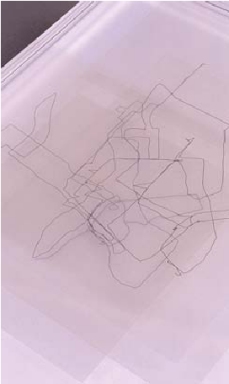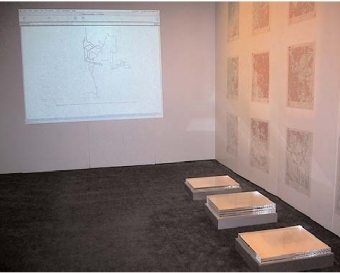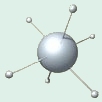|
 There is an aesthetic quality to our travels as we continually
reinscribe the landscape through our journeys across
it, and it is this quality that Teri Rueb exposes through her
work, The Choreography of Everyday Movement.
Participants, equipped with a GPS transponder, reveal the
sociopolitical and poetic patterns resulting from the intersection
of the human and urban (i.e. city) bodies. As the
'dancers' move across the urban landscape (this is, after
all, about choreography), they are represented as a single
dot on a blank canvas (or sometimes overlaid on a transportation
grid), which creates the line of their daily travels.
This abstraction decontextualizes their actions to that of
pure line and movement in the real-time component. On
the screen there are few cues to determine the (local)
geopolitical milieu surrounding the traveler at any given
instant. In this way, the daily movement of the body is aestheticized
to its most basic elements, almost as if it were
reduced to the stylus on a child's Etch-a-Sketch toy.
Neither performer nor audience see one another on the
browser stage, creating a unique sense of gaze that
stands in contrast to traditional performative models.
There is an aesthetic quality to our travels as we continually
reinscribe the landscape through our journeys across
it, and it is this quality that Teri Rueb exposes through her
work, The Choreography of Everyday Movement.
Participants, equipped with a GPS transponder, reveal the
sociopolitical and poetic patterns resulting from the intersection
of the human and urban (i.e. city) bodies. As the
'dancers' move across the urban landscape (this is, after
all, about choreography), they are represented as a single
dot on a blank canvas (or sometimes overlaid on a transportation
grid), which creates the line of their daily travels.
This abstraction decontextualizes their actions to that of
pure line and movement in the real-time component. On
the screen there are few cues to determine the (local)
geopolitical milieu surrounding the traveler at any given
instant. In this way, the daily movement of the body is aestheticized
to its most basic elements, almost as if it were
reduced to the stylus on a child's Etch-a-Sketch toy.
Neither performer nor audience see one another on the
browser stage, creating a unique sense of gaze that
stands in contrast to traditional performative models.
The expressive character of the line reveals itself as the
archived data is represented over time in the form of printouts
that are generated by the installation and sandwiched
between layers of ½" glass. When the layering of the printouts
represents a z-axis of time, the abstracted
line of the participant's movements -- when
placed in reference to one another sans landmarks
-- reveals the patterns of our daily
'dances.' These performances have their own
beauty, but also reveal the habitual and the
divergent in the day-to-day.
 The question one might have concerns the totality
of abstraction of the event. Is the performer
uninfluenced by the introduction of the GPS
system? Or is there a form of Hawthorne Effect
caused by the unconscious desire to create
aesthetically pleasing movement patterns? Or
are these largely defined by the sociocultural
milieu of the given city? Regardless, The
Choreography of Everyday Movement is a well articulated,
early GPS-based new media work in
which Rueb, with the help of Computer Science
collaborator In Choi, poses interesting questions.
The question one might have concerns the totality
of abstraction of the event. Is the performer
uninfluenced by the introduction of the GPS
system? Or is there a form of Hawthorne Effect
caused by the unconscious desire to create
aesthetically pleasing movement patterns? Or
are these largely defined by the sociocultural
milieu of the given city? Regardless, The
Choreography of Everyday Movement is a well articulated,
early GPS-based new media work in
which Rueb, with the help of Computer Science
collaborator In Choi, poses interesting questions.
http://research.umbc.edu/~rueb/trackings/index.html
|

